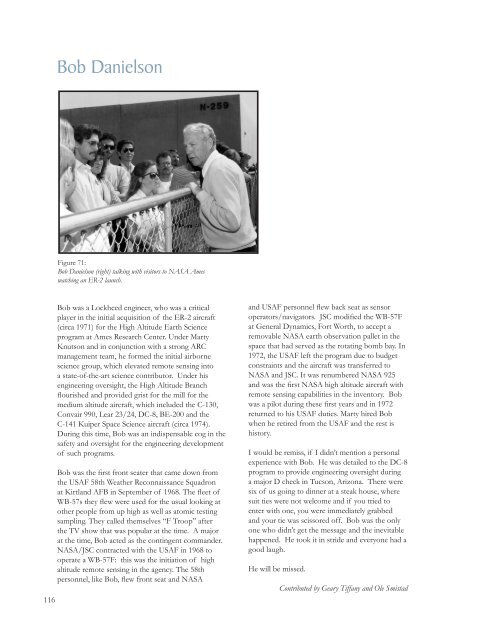2009 Annual Report - NASA Airborne Science Program
2009 Annual Report - NASA Airborne Science Program
2009 Annual Report - NASA Airborne Science Program
You also want an ePaper? Increase the reach of your titles
YUMPU automatically turns print PDFs into web optimized ePapers that Google loves.
Bob Danielson<br />
Figure 71:<br />
Bob Danielson (right) talking with visitors to <strong>NASA</strong> Ames<br />
watching an ER-2 launch.<br />
116<br />
Bob was a Lockheed engineer, who was a critical<br />
player in the initial acquisition of the ER-2 aircraft<br />
(circa 1971) for the High Altitude Earth <strong>Science</strong><br />
program at Ames Research Center. Under Marty<br />
Knutson and in conjunction with a strong ARC<br />
management team, he formed the initial airborne<br />
science group, which elevated remote sensing into<br />
a state-of-the-art science contributor. Under his<br />
engineering oversight, the High Altitude Branch<br />
flourished and provided grist for the mill for the<br />
medium altitude aircraft, which included the C-130,<br />
Convair 990, Lear 23/24, DC-8, BE-200 and the<br />
C-141 Kuiper Space <strong>Science</strong> aircraft (circa 1974).<br />
During this time, Bob was an indispensable cog in the<br />
safety and oversight for the engineering development<br />
of such programs.<br />
Bob was the first front seater that came down from<br />
the USAF 58th Weather Reconnaissance Squadron<br />
at Kirtland AFB in September of 1968. The fleet of<br />
WB-57s they flew were used for the usual looking at<br />
other people from up high as well as atomic testing<br />
sampling. They called themselves “F Troop” after<br />
the TV show that was popular at the time. A major<br />
at the time, Bob acted as the contingent commander.<br />
<strong>NASA</strong>/JSC contracted with the USAF in 1968 to<br />
operate a WB-57F: this was the initiation of high<br />
altitude remote sensing in the agency. The 58th<br />
personnel, like Bob, flew front seat and <strong>NASA</strong><br />
and USAF personnel flew back seat as sensor<br />
operators/navigators. JSC modified the WB-57F<br />
at General Dynamics, Fort Worth, to accept a<br />
removable <strong>NASA</strong> earth observation pallet in the<br />
space that had served as the rotating bomb bay. In<br />
1972, the USAF left the program due to budget<br />
constraints and the aircraft was transferred to<br />
<strong>NASA</strong> and JSC. It was renumbered <strong>NASA</strong> 925<br />
and was the first <strong>NASA</strong> high altitude aircraft with<br />
remote sensing capabilities in the inventory. Bob<br />
was a pilot during these first years and in 1972<br />
returned to his USAF duties. Marty hired Bob<br />
when he retired from the USAF and the rest is<br />
history.<br />
I would be remiss, if I didn’t mention a personal<br />
experience with Bob. He was detailed to the DC-8<br />
program to provide engineering oversight during<br />
a major D check in Tucson, Arizona. There were<br />
six of us going to dinner at a steak house, where<br />
suit ties were not welcome and if you tried to<br />
enter with one, you were immediately grabbed<br />
and your tie was scissored off. Bob was the only<br />
one who didn’t get the message and the inevitable<br />
happened. He took it in stride and everyone had a<br />
good laugh.<br />
He will be missed.<br />
Contributed by Geary Tiffany and Ole Smistad











